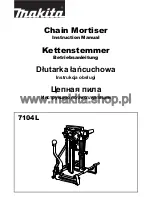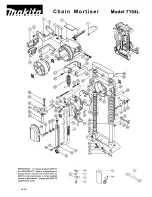
OPERATION
CUTTING OPERATIONS
There are two basic types of cuts: ripping and crosscutting.
Ripping is cutting along the length and the grain of the
workpiece. Crosscutting is cutting either across the width or
across the grain of the workpiece. Neither ripping nor
crosscutting may be done safely freehand. Ripping requires
the use of the rip fence, and crosscutting requires the miter
gauge.
CAUTION!
Before using the saw each and every time, check the
following:
1. Blade is tight on the arbor.
2. Bevel angle lock knob is tight.
3. If ripping, fence knob is tight and fence is parallel
to the miter gauge grooves.
4. Blade guard is in place and working properly.
5. Safety glasses are being worn.
The failure to adhere to these common safety rules, and
those printed in the front of this manual, can greatly
increase the likelihood of injury.
RIPPING (FIG. 27, 28)
CAUTION!
To prevent serious injury:
Never use the miter gauge when ripping.
Never use more than one rip fence during a single cut.
Do not allow familiarity or frequent use of your table
saw to cause careless mistakes. Remember that even a
careless fraction of a second is enough to cause a severe
injury.
Keep both hands away from the blade and path of the
blade.
The workpiece must have a straight edge against the
fence and must not be warped, twisted, or bowed.
1. Remove the miter gauge. Secure the rip fence to the table.
2. Raise the blade so it is about 1/8” higher than the top of
the workpiece.
3. Place the workpiece flat on the table and against the fence.
Keep the workpiece about 1” away from the blade.
4. Turn the saw ON and wait for the blade to come up to
speed.
5. Slowly feed the workpiece into the blade by pushing
forward only on the workpiece section (1) that will pass
between the blade and the fence.
(Fig. 27)
CAUTION!
AVOID KICKBACK
by pushing forward on the section of
the workpiece that passes between the blade and the fence.
Fig. 27
6. Keep your thumbs off the blade top. When both of your
thumbs touch the front edge of the table (2), finish the
cut with a push stick. Make a push stick using the pattern
on page 22.
7. The push stick (3) should always be used. (Fig. 28)
8. Continue pushing the workpiece with the push stick
(3) until it passes the blade guard and clears the
rear of the table.
9. Never pull the piece back when the blade is turning.
Turn the switch OFF. When the blade completely
stops raise the anti-kickback pawls on each side of
the splitter and slide the workpiece out.
Fig. 28
18
Summary of Contents for BTS10W4
Page 7: ...CARTON CONTENTS 7 A M S R B F G C D E Q P K J I H O N L ...
Page 25: ...25 ...
Page 27: ...MOTOR DIAGRAM 27 ...











































